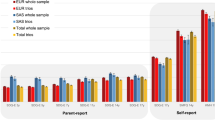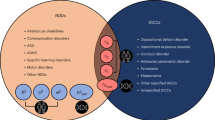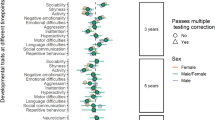Abstract
Common genetic influences offer a partial explanation for comorbidity between different psychiatric disorders1,2,3. However, the genetics underlying co-development—the cross-domain co-occurrence of patterns of change over time—of psychiatric symptoms during childhood and adolescence has not been well explored. Here, we show genetic influence on joint symptom trajectories of parent-reported conduct and emotional problems (overall N = 15,082) across development (4–16 years) using both twin- and genome-wide polygenic score analyses (genotyped N = 2,610). Specifically, we found seven joint symptom trajectories, including two characterized by jointly stable and jointly increasing symptoms of conduct and emotional problems, respectively (7.3% of the sample, collectively). Twin modelling analyses revealed substantial genetic influence on trajectories (heritability estimates range of 0.41–0.78). Furthermore, individuals’ risk of being classified in the most symptomatic trajectory classes was significantly predicted by polygenic scores for years-of-education-associated alleles and depressive symptoms-associated alleles. Complementary analyses of child self-reported symptoms across late childhood and early adolescence yielded broadly similar results. Taken together, our results indicate that genetic factors are involved in the co-development of conduct and emotional problems across childhood and adolescence, and that individuals with co-developing symptoms across multiple domains may represent a clinical subgroup characterized by increased levels of genetic risk.
This is a preview of subscription content, access via your institution
Access options
Access Nature and 54 other Nature Portfolio journals
Get Nature+, our best-value online-access subscription
$29.99 / 30 days
cancel any time
Subscribe to this journal
Receive 12 digital issues and online access to articles
$119.00 per year
only $9.92 per issue
Buy this article
- Purchase on Springer Link
- Instant access to full article PDF
Prices may be subject to local taxes which are calculated during checkout



Similar content being viewed by others
References
Kendler, K. S., Prescott, C. A., Myers, J. & Neale, M. C. The structure of genetic and environmental risk factors for common psychiatric and substance use disorders in men and women. Arch. Gen. Psychiatry 60, 929–937 (2003).
Lee, S. H. et al. Genetic relationship between five psychiatric disorders estimated from genome-wide SNPs. Nat. Genet. 45, 984–994 (2013).
Pettersson, E., Larsson, H. & Lichtenstein, P. Common psychiatric disorders share the same genetic origin: a multivariate sibling study of the Swedish population. Mol. Psychiatry 21, 717–721 (2016).
Kessler, R. C., Chiu, W. T., Demler, O., Merikangas, K. R. & Walters, E. E. Prevalence, severity, and comorbidity of 12-month DSM-IV disorders in the National Comorbidity Survey Replication. Arch. Gen. Psychiatry 62, 617–627 (2005).
Krueger, R. F. & Markon, K. E. Reinterpreting comorbidity: a model-based approach to understanding and classifying psychopathology. Annu. Rev. Clin. Psychol. 2, 111–133 (2006).
Battaglia, M., Przybeck, T. R., Bellodi, L. & Cloninger, C. R. Temperament dimensions explain the comorbidity of psychiatric disorders. Compr. Psychiatry 37, 292–298 (1996).
Rhee, S. H., Lahey, B. B. & Waldman, I. D. Comorbidity among dimensions of childhood psychopathology: converging evidence from behavior genetics. Child Dev. Perspect. 9, 26–31 (2015).
Merikangas, K. R. et al. Lifetime prevalence of mental disorders in U.S. adolescents: results from the National Comorbidity Survey Replication—Adolescent Supplement (NCS-A). J. Am. Acad. Child Adolesc. Psychiatry 49, 980–989 (2010).
Lewinsohn, P. M., Rohde, P. & Seeley, J. R. Adolescent psychopathology: III. The clinical consequences of comorbidity. J. Am. Acad. Child Adolesc. Psychiatry 34, 510–519 (1995).
Angold, A., Costello, E. J. & Erkanli, A. Comorbidity. J. Child Psychol. Psychiatry 40, 55–87 (1999).
Costello, E. J., Mustillo, S., Erkanli, A., Keeler, G. & Angold, A. Prevalence and development of psychiatric disorders in childhood and adolescence. Arch. Gen. Psychiatry 60, 837–844 (2003).
Merikangas, K. R. et al. Prevalence and treatment of mental disorders among US children in the 2001–2004 NHANES. Pediatrics 125, 75–81 (2010).
Cunningham, N. R. & Ollendick, T. H. Comorbidity of anxiety and conduct problems in children: implications for clinical research and practice. Clin. Child Fam. Psychol. Rev. 13, 333–347 (2010).
Riglin, L. et al. Profiling depression in childhood and adolescence: the role of conduct problems. J. Child Psychol. Psychiatry 57, 481–490 (2016).
Wolff, J. C. & Ollendick, T. H. The comorbidity of conduct problems and depression in childhood and adolescence. Clin. Child Fam. Psychol. Rev. 9, 201–220 (2006).
Hofstra, M. B., van der Ende, J. & Verhulst, F. C. Continuity and change of psychopathology from childhood into adulthood: a 14-year follow-upstudy. J. Am. Acad. Child Adolesc. Psychiatry 39, 850–858 (2000).
Costello, E. J., Copeland, W. E. & Angold, A. Trends in psychopathology across the adolescent years: What changes when children become adolescents, and when adolescents become adults? J. Child Psychol. Psychiatry 52, 1015–1025 (2011).
Letcher, P., Smart, D., Sanson, A. & Toumbourou, J. W. Psychosocial precursors and correlates of differing internalizing trajectories from 3 to 15 years. Soc. Dev. 18, 618–646 (2009).
Odgers, C. L. et al. Female and male antisocial trajectories: from childhood origins to adult outcomes. Dev. Psychopathol. 20, 673–716 (2008).
Lahey, B. B., Zald, D. H., Hakes, J. K., Krueger, R. F. & Rathouz, P. J. Patterns of heterotypic continuity associated with the cross-sectional correlational structure of prevalent mental disorders in adults. JAMA Psychiatry 71, 989–996 (2014).
Reinke, W. M. & Ostrander, R. Heterotyic and homotypic continuity: the moderating effects of age and gender. J. Abnorm. Child Psychol. 36, 1109–1121 (2008).
Rutter, M., Kim-Cohen, J. & Maughan, B. Continuities and discontinuities in psychopathology between childhood and adult life. J. Child Psychol. Psychiatry 47, 276–295 (2006).
Fanti, K. Using a person-centered methodology to investigate the co-occurrence between psychopathological problems. Ann. Depress. Anxiety 1, 1–5 (2014).
Barker, E. D. & Maughan, B. Differentiating early-onset persistent versus childhood-limited conduct problem youth. Am. J. Psychiatry 166, 900–908 (2009).
Moffitt, T. E., Caspi, A., Dickson, N., Silva, P. & Stanton, W. Childhood-onset versus adolescent-onset antisocial conduct problems in males: natural history from ages 3 to 18 years. Dev. Psychopathol. 8, 399–424 (1996).
Maughan, B., Pickles, A., Rowe, R., Costello, E. J. & Angold, A. Developmental trajectories of aggressive and non-aggressive conduct problems. J. Quant. Criminol. 16, 199–221 (2000).
Bongers, I. L., Koot, H. M., van der Ende, J. & Verhulst, F. C. Developmental trajectories of externalizing behaviors in childhood and adolescence. Child Dev. 75, 1523–1537 (2004).
Wildeboer, A. et al. Early childhood aggression trajectories: associations with teacher-reported problem behaviour. Int. J. Behav. Dev. 39, 221–234 (2015).
Leve, L. D., Kim, H. K. & Pears, K. C. Childhood temperament and family environment as predictors of internalizing and externalizing trajectories from ages 5 to 17. J. Abnorm. Child Psychol. 33, 505–520 (2005).
Shaw, D. S., Lacourse, E. & Nagin, D. S. Developmental trajectories of conduct problems and hyperactivity from ages 2 to 10. J. Child Psychol. Psychiatry Allied Discip. 46, 931–942 (2005).
Feng, X., Shaw, D. S. & Silk, J. S. Developmental trajectories of anxiety symptoms among boys across early and middle childhood. J. Abnorm. Psychol. 117, 32–47 (2008).
Davis, S., Votruba‐Drzal, E. & Silk, J. S. Trajectories of internalizing symptoms from early childhood to adolescence: associations with temperament and parenting. Soc. Dev. 24, 501–520 (2015).
Dekker, M. C. et al. Developmental trajectories of depressive symptoms from early childhood to late adolescence: gender differences and adult outcome. J. Child Psychol. Psychiatry 48, 657–666 (2007).
Nagin, D. S. & Tremblay, R. E. Analyzing developmental trajectories of distinct but related behaviors: a group-based method. Psychol. Methods 6, 18–33 (2001).
Gilliom, M. & Shaw, D. Codevelopment of externalizing and internalizing problems in early childhood. Dev. Psychopathol. 16, 313–333 (2004).
Fanti, K. & Henrich, C. C. Trajectories of pure and co-occurring internalizing and externalizing problems from age 2 to age 12: findings from the National Institute of Child Health and Human Development Study of Early Child Care. Dev. Psychol. 46, 1159–1175 (2010).
Nivard, M. G. et al. Joint developmental trajectories of internalizing and externalizing disorders between childhood and adolescence. Dev. Psychopathol. 29, 919–928 (2017).
Reinke, W. M., Eddy, J. M., Dishion, T. J. & Reid, J. B. Joint trajectories of symptoms of disruptive behavior problems and depressive symptoms during early adolescence and adjustment problems during emerging adulthood. J. Abnorm. Child Psychol. 40, 1123–1136 (2012).
Wiesner, M. & Kim, H. K. Co-occurring delinquency and depressive symptoms of adolescent boys and girls: a dual trajectory modeling approach. Dev. Psychol. 42, 1220–1235 (2006).
Anttila, A. V. et al. Analysis of shared heritability in common disorders of the brain. Preprint at https://www.biorxiv.org/content/early/2017/09/06/048991 (2017).
Hannigan, L. J., Walaker, N., Waszczuk, M., McAdams, T. & Eley, T. C. Aetiological influences on stability and change in emotional and behavioural problems across development: a systematic review. Psychopathol. Rev. 4, 1–57 (2016).
Lacourse, E. et al. A longitudinal twin study of physical aggression during early childhood: evidence for a developmentally dynamic genome. Psychol. Med. 44, 2617–2627 (2014).
Pingault, J.-B., Rijsdijk, F., Zheng, Y., Plomin, R. & Viding, E. Developmentally dynamic genome: evidence of genetic influences on increases and decreases in conduct problems from early childhood to adolescence. Sci. Rep. 5, 10053 (2015).
Lubke, G. H. et al. A powerful phenotype for gene-finding studies derived from trajectory analyses of symptoms of anxiety and depression between age seven and 18. Am. J. Med. Genet. B Neuropsychiatr. Genet. 171, 948–957 (2016).
Harden, K. P., Quinn, P. D. & Tucker-Drob, E. M. Genetically influenced change in sensation seeking drives the rise of delinquent behavior during adolescence. Dev. Sci. 15, 150–163 (2012).
Fontaine, N. M. G., Rijsdijk, F. V., McCrory, E. J. P. & Viding, E. Etiology of different developmental trajectories of callous-unemotional traits. J. Am. Acad. Child Adolesc. Psychiatry 49, 656–664 (2010).
Plomin, R., DeFries, J. C., Knopik, V. S. & Neiderhiser, J. M. Top 10 replicated findings from behavioral genetics. Perspect. Psychol. Sci. 11, 3–23 (2016).
Dudbridge, F. Power and predictive accuracy of polygenic risk scores. PLoS Genet. 9, e1003348 (2013).
Krapohl, E. et al. Multi-polygenic score approach to trait prediction. Mol. Psychiatry 23, 1368–1374 (2018).
Krapohl, E. et al. Phenome-wide analysis of genome-wide polygenic scores. Mol. Psychiatry 21, 1188–1193 (2016).
Belsky, D. W. et al. The genetics of success. Psychol. Sci. 27, 957–972 (2016).
McDonald, R. P. & Ho, M. H. Principles and practice in reporting structural equation analyses. Psychol. Methods 7, 64–82 (2002).
Costello, D., Swendsen, J., Roes, J. & Dierker, L. C. Risk and protective factors associated with trajectories of depressed mood from adolescence to early adulthood. J. Consult. Clin. Psychol. 76, 173–183 (2008).
Toumbourou, J. W., Williams, I., Letcher, P., Sanson, A. & Smart, D. Developmental trajectories of internalising behaviour in the prediction of adolescent depressive symptoms. Aust. J. Psychol. 63, 214–223 (2011).
Lahey, B. B., Loeber, R., Burke, J., Rathouz, P. J. & McBurnett, K. Waxing and waning in concert: dynamic comorbidity of conduct disorder with other disruptive and emotional problems over 7 years among clinic-referred boys. J. Abnorm. Psychol. 111, 556–567 (2002).
Frick, P. J. & Morris, A. S. Temperament and developmental pathways to conduct problems. J. Clin. Child Adolesc. Psychol. 33, 54–68 (2004).
Dodge, K. A. Social-cognitive mechanisms in the development of conduct disorder and depression. Annu. Rev. Psychol. 44, 559–584 (1993).
Burt, S. A., McGue, M., Krueger, R. F. & Iacono, W. G. How are parent–child conflict and childhood externalizing symptoms related over time? Results from a genetically informative cross-lagged study. Dev. Psychopathol. 17, 145–165 (2005).
Avinun, R. & Knafo, A. Parenting as a reaction evoked by children’s genotype: a meta-analysis of children-as-twins studies. Personal. Soc. Psychol. Rev. 18, 87–102 (2014).
Caspi, A. et al. The p factor: one general psychopathology factor in the structure of psychiatric disorders? Clin. Psychol. Sci. 2, 119–137 (2014).
Eley, T. C. General genes: a new theme in developmental psychopathology. Curr. Dir. Psychol. Sci. 6, 90–95 (1997).
Lahey, B. B., Van Hulle, Ca, Singh, A. L., Waldman, I. D. & Rathouz, P. J. Higher-order genetic and environmental structure of prevalent forms of child and adolescent psychopathology. Arch. Gen. Psychiatry 68, 181–189 (2011).
Visscher, P. M. Human complex trait genetics in the 21st century. Genetics 202, 377–379 (2016).
Enders, C., & Bandalos, D. The relative performance of full information maximum likelihood estimation for missing data in structural equation models. Struct. Equ. Modeling 8, 430–457 (2001).
Haworth, C. Ma, Davis, O. S. P. & Plomin, R. Twins Early Development Study (TEDS): a genetically sensitive investigation of cognitive and behavioral development from childhood to young adulthood. Twin Res. Hum. Genet. 16, 117–125 (2013).
Goodman, R. The Strengths and Difficulties Questionnaire: a research note. J. Child Psychol. Psychiatry 38, 581–586 (1997).
Gadermann, A. M., Guhn, M. & Zumbo, B. D. Estimating ordinal reliability for Likert-type and ordinal item response data: a conceptual, empirical, and practical guide. Pract. Assess. Res. Eval. 17, 1–13 (2012).
Lo, Y., Mendell, N. R. & Rubin, D. B. Testing the number of components in a normal mixture. Biometrika 88, 767–778 (2001).
Vuong, Q. Likelihood ratio tests for model selection and nonnested hypotheses. Econometrica 57, 307–333 (1989).
Ram, N. & Grimm, K. J. Growth mixture modeling: a method for identifying differences in longitudinal change among unobserved groups. Int. J. Behav. Dev. 33, 565–576 (2009).
Sivakumaran, S. et al. Abundant pleiotropy in human complex diseases and traits. Am. J. Hum. Genet. 89, 607–618 (2011).
Okbay, A. et al. Genome-wide association study identifies 74 loci associated with educational attainment. Nature 533, 539–542 (2016).
Okbay, A. et al. Genetic variants associated with subjective well-being, depressive symptoms, and neuroticism identified through genome-wide analyses. Nat. Genet. 48, 624–633 (2016).
Muthén, L. K. & Muthén, B. O. Mplus User’s Guide 8th edn (Muthén & Muthén, Los Angeles, CA, 2017).
Hallquist, M. N. & Wiley, J. F. MplusAutomation: an R Package for facilitating large-scale latent variable analyses in Mplus. Struct. Equ. Modeling 25, 621–638 (2018).
Neale, M. C. et al. OpenMx 2.0: extended structural equation and statistical modeling. Psychometrika 26, 99–127 (2015).
Jelicić, H., Phelps, E. & Lerner, R. M. Use of missing data methods in longitudinal studies: the persistence of bad practices in developmental psychology. Dev. Psychol. 45, 1195–1199 (2009).
Acknowledgements
We gratefully acknowledge the ongoing contribution of the participants in the TEDS and their families. TEDS is supported by a programme grant from the UK Medical Research Council (MR/M021475/1 and previously G0901245), with additional support from the US National Institutes of Health (AG046938) and the European Commission (602768 and 295366). L.J.H. is supported by a 1 + 3 PhD studentship from the UK Economic and Social Research Council (ESRC). J.-B.P. is a fellow of MQ: Transforming Mental Health. E.K. is supported by the MRC/IoPPN Excellence Award. T.A.M. is supported by a Sir Henry Dale Fellowship, jointly funded by the Wellcome Trust and the Royal Society (107706/Z/15/Z). This study presents independent research part-funded by the National Institute for Health Research (NIHR) Biomedical Research Centre at South London and Maudsley NHS Foundation Trust and King’s College London. The views expressed are those of the authors and not necessarily those of the NHS, the NIHR or the Department of Health. The funders had no role in the study design, data collection and analysis, decision to publish, or preparation of the manuscript. We would like to thank R. Plomin for his input and advice.
Author information
Authors and Affiliations
Contributions
L.J.H., T.C.E., T.A.M. and F.V.R. conceived of the investigation. L.J.H., J.-B.P. and E.K. discussed the analytic strategy, and L.J.H. and E.K. carried out the statistical analyses. L.J.H., T.C.E., T.A.M. and F.V.R. worked on interpreting the results and refining the analyses. L.J.H. wrote the manuscript, and all authors critically reviewed the manuscript.
Corresponding author
Ethics declarations
Competing interests
The authors declare no competing interests.
Additional information
Publisher’s note: Springer Nature remains neutral with regard to jurisdictional claims in published maps and institutional affiliations.
Supplementary information
Supplementary Information
Supplementary Figures 1–7, Supplementary Tables 1–9, Supplementary Note 1, Supplementary Methods, Supplementary References 1–10.
Rights and permissions
About this article
Cite this article
Hannigan, L.J., Pingault, JB., Krapohl, E. et al. Genetics of co-developing conduct and emotional problems during childhood and adolescence. Nat Hum Behav 2, 514–521 (2018). https://doi.org/10.1038/s41562-018-0373-9
Received:
Accepted:
Published:
Issue Date:
DOI: https://doi.org/10.1038/s41562-018-0373-9
This article is cited by
-
Examining intergenerational risk factors for conduct problems using polygenic scores in the Norwegian Mother, Father and Child Cohort Study
Molecular Psychiatry (2024)
-
Heritable Composite Phenotypes Defined by Combinations of Conduct Problem, Depression, and Temperament Features: Contributions to risk for Alcohol Problems
Research on Child and Adolescent Psychopathology (2024)
-
Polygenic risk for aggressive behavior from late childhood through early adulthood
European Child & Adolescent Psychiatry (2023)
-
Why do depression, conduct, and hyperactivity symptoms co-occur across adolescence? The role of stable and dynamic genetic and environmental influences
European Child & Adolescent Psychiatry (2021)
-
Emotional and behavioural pathways to adolescent substance use and antisocial behaviour: results from the UK Millennium Cohort Study
European Child & Adolescent Psychiatry (2021)



